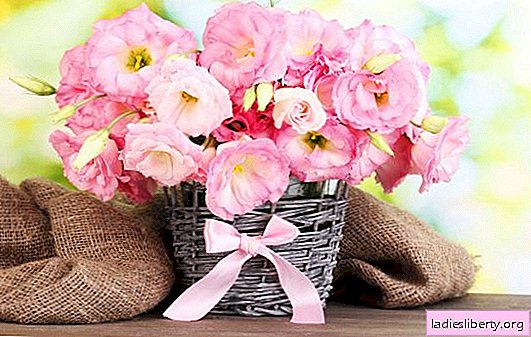
Eustoma (in a different way - lisianthus, Irish rose) is a thermophilic plant, which with proper care will take root in the middle lane. The flower grows well on protected ground - in greenhouses and greenhouses.
And at home it is better to settle it on the glassed-in balcony. Eustoma was fond of gardeners and flower beds for the various colors of their varieties and a pleasant smell - it will decorate any flower bed. It reproduces only by seeds.
Eustoma: choose a variety for cultivation
Eustoma inflorescences look like a classic rose. Her petals can be terry and simple. The leaves are ellipsoid, gray-gray, as if with a wax surface. An elegant bush, depending on the variety, is drawn up to a height of 70 cm. There are also stunted plant forms.
There are a lot of eustoma seeds for sale - many hybrids have been bred for many years. And if earlier they “yielded” only to experienced flower growers, now there are varieties intended for beginners. Planting material is very small, and therefore, sold in the form of a dragging - it is more convenient to sow them.
Choose from the entire range of “your” variety variety of eustoma in a suitable shade:
• Kyoto F1 - non-double flowers. Varieties - Picot Wine Red, Picot Pink, Picot Blue, White.
• Twinky F1 - non-double flowers. The colors of the buds are yellow, pink, purple, white.
• Mermaid F1 - non-double flowers. The colors of the buds are pale pink, blue, white, purple.
• ABC F1 - double flowers Grades - Misty Pink, Misty Blue, Blue Rome, Purpl.
• Echo F1 - double flowers Varieties - Champagne, Blue Picoti, Pink Picoti, Blue, Yellow, Lavender.
On packages for seeds, it is always indicated whether this eustoma is short or tall. For growing at home, more suitable compact flowers, reaching a height of 30 cm. Pay attention to what kind of plants you buy - annual or biennial. It will be easier for a beginner to grow an annual plant - the technology is simple. And preparing a two-year eustome for blooming is much more difficult - only a professional can handle it, and it will only bloom for the next season.
What place to choose for growing eustoma?
If you are going to grow eustoma, remember that loves warmth. Choose a sunny place for the flower (in the extreme case - partial shade) with high humidity. Keep the pot culture on a window facing east or west. And in the garden near the eustoma, try not to plant large plants - they will block the light.
The best soil for growing eustoma - light, good drained, rich in humus, with neutral medium. If these conditions are met, the plant will delight the grower for several seasons in a row. If eustoma is grown on weakly acidic soils, it will lead to zinc toxicity, which will significantly slow down its growth and development. In a strongly acidified soil, the plant will not take root at all. For planting a flower at home, use purchased soil mixture for flowering perennials - it is quite suitable. In the open area, it is necessary to prepare the soil on the flowerbed - earth, sand, perlite, humus, lime in the ratio 1: 1: 1: 1: 1/3.
Do not choose a large pot for eustoma - be guided by its height. For the first time a small pot of 14-16 cm in diameter will be enough for small seedlings. With further transplantations of a flower, the capacity can always be replaced. Put a drain on the bottom.
Planting eustoma seeds
If you begin to divide the flower, none of the seedlings will not take root, because their root system is very sensitive to any mechanical stress. The eustoma cuttings also do not take root - when separated from the main stem, they die completely after some time.
The only possible breeding option is planting seeds. Have you already managed to buy the sort of flower you like and have prepared a place for it? Then proceed to the preparation of seedlings. Work to see flowering by mid-summer, spend in February-March using special peat tablets (you will find in any gardening shop). They are inexpensive and easy to use.

Peat tablets
The technology is as follows:
• Place the peat tablet in a small container (you can use a plastic cup), spray it to make the substrate slightly swollen.
• Put 2-3 eustoma seeds on a nutrient medium, gently pressing them with a toothpick. Do not deepen the seeds, because they need light for germination - they will not see it in the depth of the tablet.
• Spray the peat tablet again with water or a solution of potassium permanganate from a spray bottle.
• Cover the container with cling film or bag to create a mini-greenhouse.
The rules for planting eustoma in a seedling box with the ground are exactly the same.
In order for the eustoma seeds to germinate, they need a temperature of + 20 ... +22 ° С. The first shoots may appear above the ground in 1-2 weeks, and the leaves on the stems will appear after a month. Look in stores - eustoma varieties have already been developed that can germinate much faster and at a lower temperature. Denote the main features of the care of flower seedlings:
• Occasionally remove from the film that covers the seed container, accumulated condensate.
• Spray the plant occasionally with phytosporin solution to prevent the formation of a black leg.
• Water the seedlings only when the substrate dries - on the edge of the tank.
• Seedlings will gain strength faster if they are regularly sprayed with special mineral preparations that stimulate growth.
• Having planted the seeds in the seedling box, in the phase of 2-3 full-fledged leaves, dive eustoma in separate containers. The case is quite time-consuming, since the root system of the plant can be damaged. Therefore, it is recommended to use peat tablets.

Ready to plant seedlings eustoma
Do not rush to transfer the flower to a permanent place - young seedlings should become stronger. Planning to plant a plant on an open area? Then do not forget about his preliminary hardening. Landing is made when the threat of late spring frost has passed. Pour out the previously dug holes with water, transfer the seedlings to them with a lump of "native" land. At the same time, the distance between the flowers is 15-30 cm. Be sure to cover the new inhabitant of the garden with a plastic bottle with a cut off neck - this will save the plant from night cold, creating conditions for the greenhouse. Shelter can be removed after 2-3 weeks.
At home, everything is much easier - planting in pots or pots make, when the plant will appear 5-7 leaves. If peat tablets were used to prepare seedlings, transplant eustome directly with them. Put the container on the lit place - eustome now needs abundant light.
How to care for eustoma?
Care for eustoma in newbies often causes difficulties. The flower is not too whimsical, but requires maintaining a certain level of temperature and lighting. The basic rules are:
• Watering. Moisten the soil with the top and the edge of the pot. Use for this distilled water at room temperature - a delicate flower will not tolerate a cold liquid. Do not "flood" eustoma, but make sure that the soil is always slightly wet - pour it as soon as the top layer of the earth begins to dry out. When the plant actively blooms, it will be necessary to moisten the soil much more often - it now needs more nutrients for growth and development.
• Temperature. The optimum temperature range for eustoma during active growth and flowering is +23 ° C ... +25 ° C. In the summer, it is easily achievable both in the garden and at home, if the place of cultivation of the thermophilic beauty was originally chosen. When eustoma ottsvetet and begins to prepare for the winter, in a warm microclimate, it no longer needs - 15 ˚C will be enough.
• Lighting. Eustoma when caring for it requires an abundance of light. And it would be good if he fell on the plant from the south, east or west side. If it was not found for a flower of a bright place, in the period of growth and flowering, finish it with special lamps, otherwise you will not see beautiful and large buds. But in the period of rest the plant lives well and with a lack of light.
• Air humidity. Eustoma loves moist air. At home (especially in a dry summer) it can be difficult to achieve this. If possible, install it in the room where the flower grows, humidifier.
• Feeding. Eustoma needs regular fertilizer. Start feeding after a month after transplanting to a permanent place (around May-June) using any water-soluble fertilizer for flowering plants. Throughout the flowering eustoma feed it once a week. When the buds ottsvetut, you can reduce the fertilizer to 2-3 times a week, and the late autumn - to stop using them altogether.
• Crop. To stimulate the development of new shoots, pluck those buds that have faded, and dried leaves. Do not allow strong foliage of ornamental shrubs - this can lead to the formation of fungal diseases - from time to time carry out formative pruning.
• Preparing for the winter. When growing eustoma at home, special preparation for the state of rest is not required. But the cold in the open area, it will not suffer. There are 2 options - either just dig a flower, and plant new seeds for the next season, or transfer it to the house. In the latter case, you will need to choose a suitable pot and carefully transplant the plant and place the container in a bright, cool room. In the spring, when the earth warms up sufficiently, you can replant the eustoma in open ground.
As you grow, relocate the plant to larger pots. Repotting with caution, as even an adult plant can react badly to damage to the root system. New tank fill the soil of the same composition.
Diseases and pests: how to protect eustoma?
Eustoma, especially when it is grown at home, is rarely affected by diseases. Many insect pests leaflets and flower buds "not to taste." Therefore, to protect the flower from all sorts of misfortunes will have infrequently.
Examine eustomas regularly to see signs of disease as early as possible:
• Fusarium wilt. The disease is caused by fungal bacteria. The optimal environment for their development is the lack of lighting, high temperature and high humidity. Cope with the "scourge" is difficult, because fungi can live long in the soil. To minimize the risk of eustoma contamination with fusarium wilt, follow the rules of caring for it and buy only high-quality soil. It is better to remove the diseased plant from the site so that other specimens are not infected. Spray the soil with a solution of potassium permanganate and powder it with a mixture of ash and sulfur.
• Gray rot. The fungus appears on the eustoma leaves as dark gray spots, gradually expanding and reducing the growth and flowering of the plant. If you notice disturbing "symptoms" of the disease, spray it with a solution of Bordeaux fluid. But the strongly affected areas of the plant will have to be completely removed, otherwise - the bacteria will spread to other plantings. Flower growers are also actively using fungicides to control gray mold.
• Mealy dew. The disease is visible on a white mealy bloom, which appears on the leaves of the plant and its stems. It becomes a consequence of improper care - excessive moisture. If you do not treat eustoma, its leaves will begin to fade. Fungicidal preparations have shown themselves well in practice. And buy several items at once, alternating means.

Powdery Mildew on Eustome
Among insect pests that can annoy eustome, we distinguish whitefly, mushroom mosquitoes and aphids. They feed on the sap of the leaves of the plant, which affects their development - the foliage may turn yellow and fall off.
Noticed bugs and larvae? Get rid of them as soon as possible by treating the affected areas with insecticides. Make sure that the preparations are safe for humans - this is important when growing eustoma at home.
You can mechanically remove the larvae and adult insects from the leaves - use toothpicks or cotton buds.











